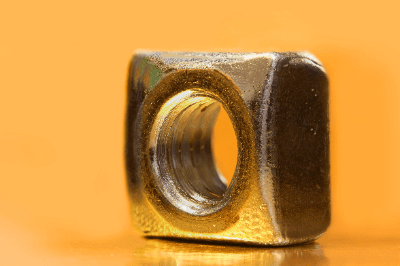What Is a Square Nut?
 A Square Nut is a square shaped fixture used in combination with a screw or bolt.
A Square Nut is a square shaped fixture used in combination with a screw or bolt.
A square nut is also called a plate nut if it is square in shape but thinner in thickness. T-slot nuts and two-hole nut plates are also square nuts.
Hexagonal nuts, which have a hexagonal shape and are widely used, require a tool to hold both the nut side and the bolt side when tightening or loosening a screw, thus requiring both hands to be occupied.
Square Nuts, on the other hand, are fitted into a groove or otherwise aligned with a corner or surface, eliminating the need to secure the nut, so that only the bolt side needs to be tightened.
Using the appropriate nut for the installation site facilitates tightening work.
Uses of Square Nut
The main applications of square nuts are for building components, electronic components, and automotive parts. Materials to be secured by square nuts include pressed products, molded resin products, and wood.
These materials are easy to form the grooves and wall shapes necessary for using square nuts, and are easy products to use square nuts.
Principle of Square Nut
Square Nuts are arranged so that at least one of the ridges of the square outline follows the wall shape of the part to be fastened, thereby preventing the nut from rotating with the bolt during fastening operations. to stop the nut from rotating.
In other words, when using square nuts, the surface of the part to be fastened by the square nut must have a wall shape that is in contact with the square nut.
Types of Square Nuts
Square nut screw sizes are from M3 to M24 and shapes in terms of height, length of one side of a regular square, and diagonal length. As for mechanical properties, the strength classifications are 4T, 5T , and 6T.
Not all square nuts are specified, and those used for wood are excluded. Square Nuts that are particularly thin are called plate nuts.
For example, in the case of an M4 size female screw, the plate nut is 1.8 mm thick, while the square nut is 3.2 mm thick, nearly twice as much. Whilst the plate nut is thinner than the square nut because it is intended for use in areas of a plate where a female screw is desired.
In addition to the plate nut, square nuts come in a variety of shapes. Typical examples include the diamond nut type and rectangular nut. These nuts are used to create space for assembly in metal products such as pressed products or plastic molded products, and are fastened using small screws or bolts. In addition, there are special nuts for pipe, knurled, irregularly shaped, special square, small size, eccentric hole, multiple holes, etc.
Other Information on Square Nuts
1. Materials and Surface Treatment of Square Nuts
The main materials used for square nuts are steel and stainless steel.
As with general nuts, surface treatments are applied, such as trivalent chromate, unichromate plating, chromate plating, nickel plating, chrome plating, and iron tetroxide coating. There are also fabrics that do not undergo surface treatment.
2. Manufacturing Process of Square Nuts
Square Nuts are mainly manufactured by a method called cold heading or cold forging.
Cutting is the best method for small quantities.